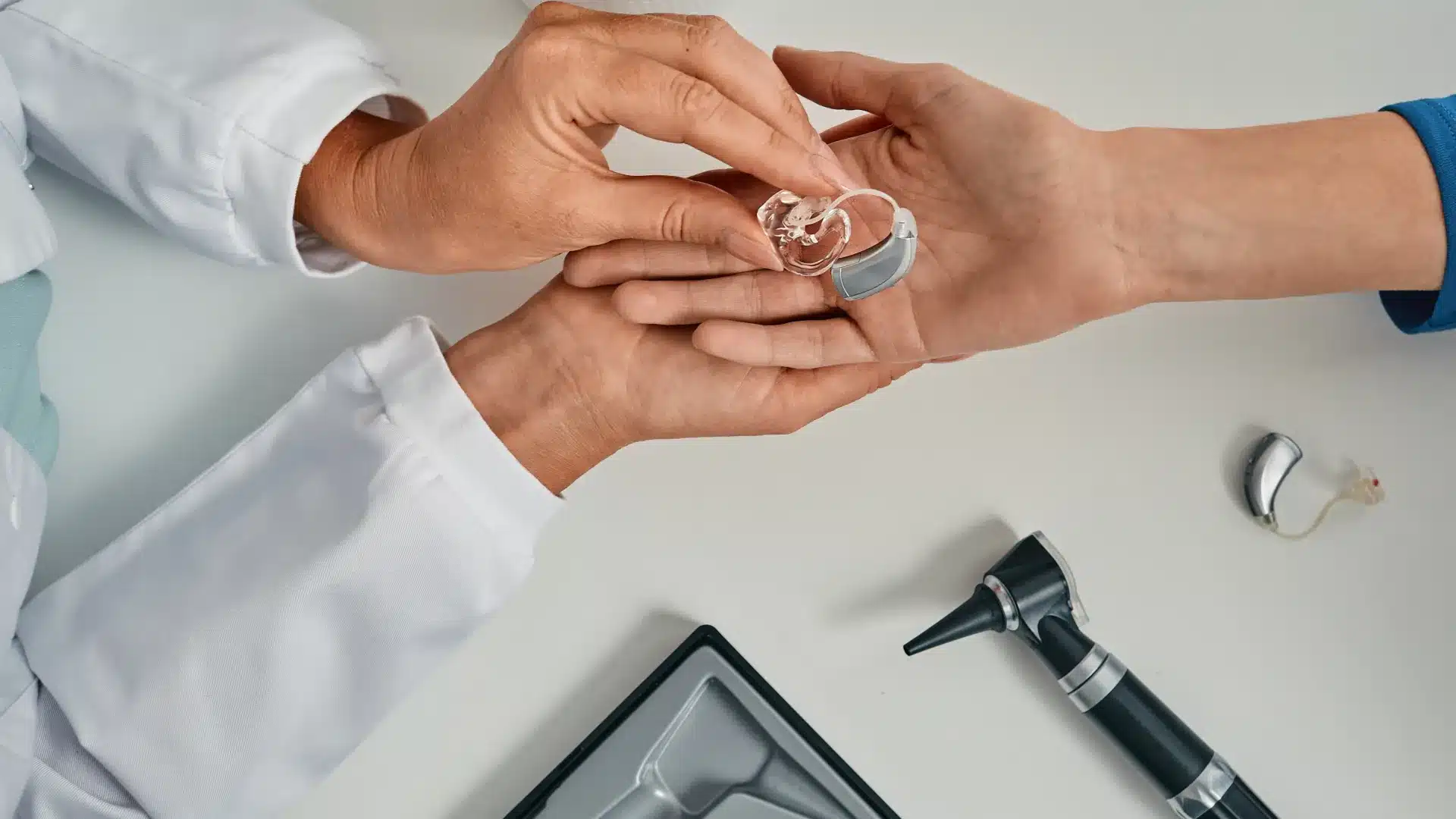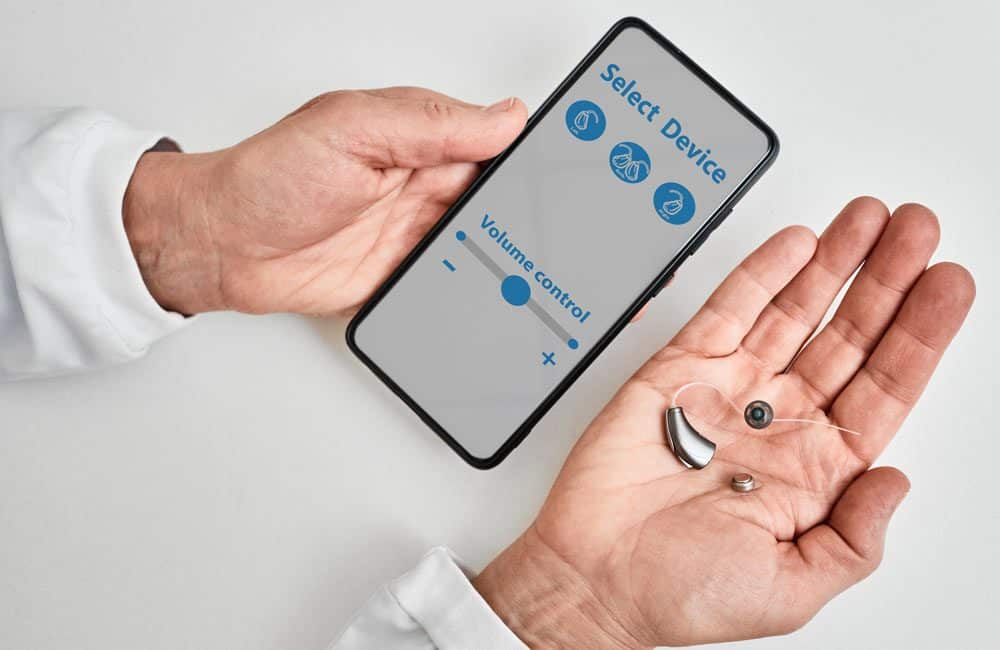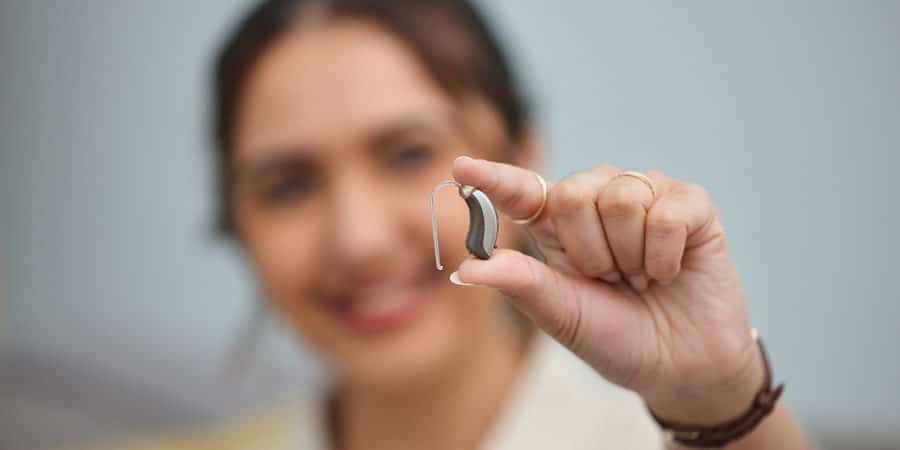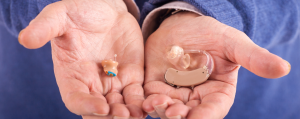Effortless Solutions for Common Hearing Aid Problems: Your Guide to Quick Fixes

17 February 2024
For many people, hearing aids are a game-changer when it comes to managing their hearing health since they provide a whole new level of clarity and connectivity. However, they have their own set of difficulties and upkeep requirements, just like any other advanced technology. Whether you’re an experienced user or a novice, you can run into common problems with feedback whistles and battery life. We’ll explore the most common problems in this in-depth article and provide you with simple remedies and quick repairs. Our goals are to make troubleshooting easier to understand, improve your experience with hearing aids, and guarantee that these amazing devices meet all of your auditory needs and help reduce hearing loss. Together, let’s go out on this path to better, more comfortable hearing.
My hearing aids have “whistling” sound or causing feedback effect
Whistling or feedback in hearing aids can be a disruptive and common issue for users, but there are several steps you can take to remedy this problem.
- Re-insert the Hearing Aids: If your hearing aids are whistling, remove them and try re-inserting them properly, as improper placement can often cause feedback.
- Adjust the Volume: Turn down the volume to see if the whistling stops. Excessive volume can cause sound to leak out, leading to feedback.
- Check for Earwax Blockage: Earwax can cause feedback by blocking sound or leading you to increase the volume excessively. Have your ears cleaned by a professional if you suspect blockage.
- Assess Fit Post Weight Loss: If you’ve lost a considerable amount of weight, the fit of your devices may have changed. Visit your hearing care professional to evaluate the fit and make necessary adjustments.
- Inspect BTE Tubing: For Behind-The-Ear models, ensure the tubing is fully connected and not brittle, hard, or cracked. Any damage can lead to feedback and may require tubing replacement.
Hearing aids makes “funny” or distorted sound
When your hearing device starts making distorted or unusual sounds, there are several potential factors to consider and steps to troubleshoot the issue:
- Battery and Contact Issues: Check the batteries and battery contacts first. Clean any corroded contacts by opening and closing the battery compartment several times, and replace any low or corroded batteries.
- Program or Memory Settings: Ensure the hearing aid isn’t set to an inappropriate program or memory setting for your current environment. Switching to a different setting more suited to your current situation might correct the distortion.
- Inspect for Damage: Physical damage to the hearing aid can cause distortion. Engage in regular maintenance and store your hearing aids in a dry, safe place away from potential harm. Daily cleaning with a soft fabric and the use of anti-humidity kits can also mitigate damage risks.
- Adjustment Accuracy: Incorrect adjustment to your personal hearing needs can result in sound distortion. Consult with a hearing care professional to ensure your hearing aid is properly configured.
- Telecoil Setting Issues: If your hearing aid is on a telecoil setting and it’s not required, it might produce distorted sounds. Switching back to the microphone setting can resolve this issue.
- Fit and Maintenance: A poor fit of the hearing aid, earmold, or slim tubes can lead to distorted sound. Earmolds that are dry, stiff, or cracked should be replaced regularly. If earwax is blocking sound from entering the middle ear, it can also lead to distortion; hence, ensuring regular, professional cleaning of your ear canals is crucial.
My hearing aid is producing too much noise
Not only can excessive noise or feedback from hearing aids be irritating, but they can also negatively impact your overall hearing experience. Here’s how to deal with these extraneous noises and maybe lessen them:
- Recognize the Source of Feedback: Whistling, squealing, or screeching noises are the most common forms of feedback from hearing aids. It occurs when sound enters the microphone again after escaping the ear canal and amplifies again. Even though feedback control mechanisms are frequently found in modern hearing aids, feedback can still happen for a variety of reasons.
- Make Sure It Fits: A common reason for feedback is an improperly fitting device. Sound leakage and other problems may occur if the device is not securely fitted inside the ear. Check the fit frequently, particularly if you’ve changed significantly in weight. If necessary, get professional advice for adjustments or new earmolds.
- Control Earwax Buildup: Too much ear wax can obstruct sound waves and cause feedback. Steer clear of at-home removal techniques as they can be inefficient and dangerous. Have your ears professionally cleaned instead to guarantee that sound can pass through.
- Adjust the Volume: By causing sound to re-enter the microphone, excessively high volume settings can make feedback issues worse. Try turning down the volume to see if that stops the feedback.
- Examine the Hearing Aid for Damage: Feedback may be caused by normal wear and tear or external damage, such as a broken tube or a misplaced microphone. Instead of attempting do-it-yourself repairs, have a professional examine and fix your hearing aid.
A visit to a hearing healthcare professional is imperative in cases of persistent feedback. They can make sure your device is operating comfortably and optimally by carefully assessing the fit, looking for wax buildup, and checking for any mechanical or electrical problems.
Hearing aids are not loud enough: Volume Control

There are a few ways to change the volume of your hearing aids if you find that they aren’t loud enough to suit your needs:
- Learn the Different Volume Adjustment Techniques: Push buttons, rotary wheels, toggle switches, remote controls, and even smartphone apps are just a few of the ways that modern hearing aids can be adjusted. Understanding the settings of your particular device is essential to making efficient modifications.
- Check for Temporary Changes: Remember that most volume changes are only momentary. The hearing aid typically returns to the factory defaults or the most recent program that your audiologist set when it is turned off or reset.
- Make Use of Automatic Adjustments: To ensure a consistent hearing experience, many hearing aids have automatic volume control that adjusts based on the surrounding environment. In spite of this, manual overrides are offered in case you need to change the volume to your preferred level.
- Think About Clarity, Not Just Volume: Improving hearing doesn’t always require turning up the volume. If the sound is clearer but still louder, there may be a problem with the settings on your hearing aid or your auditory system. Higher volume does not always translate into better clarity or word recognition.
- Speak with a Professional: It may be time to see your audiologist if you’re having trouble with volume on a regular basis. They can reevaluate your hearing requirements, modify the equipment as needed, or suggest other approaches to improve your hearing. It’s critical to confirm that your hearing aids are more effective and clearer for your particular needs, in addition to being louder.
My hearing aid has gotten wet
If your hearing aid gets wet, you must act quickly and appropriately because water exposure can seriously damage them. The actions to take are as follows:
- Remove and Turn Off: Remove the hearing aid from the water right away, then turn it off. Avoid turning it on to see if it’s working if it’s already off, as this could lead to more damage.
- Remove the battery: To take out the battery, open the compartment holding the battery and take it out and inspect the battery. If it has come into contact with water, throw it away as it is probably damaged and could cause damage to the device if put back in.
- Dry Gently: Use a dry cloth to gently pat the hearing aid. On high settings, stay away from using direct heat sources like hair dryers as this can cause components to melt or warp. Instead, put the hearing aid in a dry box or dehumidifier made especially for electronics, or use a hairdryer set to low or cool.
- Refrain from Overheating: Never dry your hearing aid in a conventional oven or microwave. Elevated temperatures have the potential to permanently harm the fragile electronic parts within.
- Wait Before Turning On: Refrain from turning on the hearing aid right away after it has dried completely. Give it enough time to dry completely, which may mean keeping it in a dry, secure location for the entire night or longer.
- Speak with an Expert: See an audiology professional or hearing aid specialist if, after drying, the device stops working properly or if you’re not sure if there is any damage. They are able to determine the degree of the water damage and provide recommendations for replacement or repair. A wet device can be saved with prompt and appropriate action, but expert advice is important in deciding on the best course of action.
Hearing aid is causing sore ears
Wearing hearing aids can often cause discomfort or soreness, particularly for first-time users or those whose devices don’t fit well. The following actions can be taken to reduce and avoid pain:
- Verify the correct insertion of the hearing aid by checking its placement. Pain or discomfort may result from improper placement. Go over the instructions again or ask your audiologist to walk you through the correct insertion methods.
- Give Your Ears Time to Adjust: Give your ears time to adjust if you’re new to wearing hearing aids. Your body needs time to adjust to new glasses or shoes, just like with anything else. Gradually extend the amount of time you spend wearing the hearing aid by starting with a few hours each day.
- Frequent Cleaning: An accumulation of debris or earwax on the hearing aid may irritate it or infect it, resulting in discomfort. As directed by the manufacturer or your audiologist, clean your hearing aids on a regular basis.
- Determine Allergies: Some people may have allergies to the materials that go into making earmolds or hearing aids. Speak with a professional who can test for allergies and recommend substitute materials if you think you may be experiencing an allergic reaction.
- Seek Professional Fit: One of the most common reasons for discomfort is a bad fit. The hearing aid might need to be adjusted or remade if it feels too tight, too loose, or just uncomfortable overall. Custom-fitted hearing aids can greatly increase comfort because they are made to fit the particular curves of your ear.
- Speak with an Expert: It’s important to speak with a hearing care specialist if the discomfort doesn’t go away after attempting these fixes. They are able to evaluate the fit, make adjustments, find additional sources of discomfort, and offer suitable remedies. A successful hearing aid experience depends on making sure your devices are comfortable.
Battery life common issues
Battery life is an important part of how hearing aids work, and knowing what affects it can help you set realistic goals and get better overall device performance. Here are some key points about battery life in modern hearing aids:
- Power Requirements for Advanced Features: Noise reduction algorithms, directional microphones, Bluetooth connectivity, and other digital and wireless features are all standard on modern hearing aids. Although these improve the quality of sound, they also use more power, which reduces battery life.
- Sizes of Devices and Batteries: Hearing aids are getting smaller and more discrete, which means batteries need to be smaller too. Because of their smaller capacity, these compact batteries might not last as long as their larger counterparts.
- Battery Technology Advances: Due to their size efficiency and consistent power, zinc-air batteries are frequently used in hearing aids. Despite the progress made, these batteries still have drawbacks, including a limited lifespan once activated and sensitivity to changes in humidity and temperature.
- Variable Consumption: Depending on the use of specific features like wireless streaming or the complexity of the listening environment, the amount of power consumed can vary significantly day to day. It is challenging to estimate a battery’s exact lifespan because of this variability.
- Managing Battery Life: Users should make sure their hearing aids are turned off when not in use, store their batteries at room temperature, and look for any features that might be drawing too much power. If reliable battery life is an issue, it’s also a good idea to have extra batteries on hand or to think about rechargeable alternatives.
Knowing how hearing aid batteries work and getting used to them can make your experience much better and make sure that your device is always ready when you need it.
Are my headaches caused by a hearing aid?
When using hearing aids, headaches can happen, especially to first-time users or people whose devices don’t fit well. Comfort and the best functioning of your hearing aids depend on your understanding of the causes and solutions:
- Pressure and Fit: Hearing aids that don’t fit right can put pressure on your ears, which can be painful or give you headaches. It’s important to make sure the hearing aid fits properly and isn’t too tight or loose. For a more comfortable fit, the hearing aid may need to be adjusted or replaced.
- Getting Used to New Sounds: When someone is new to hearing aids, their brain needs some time to get used to how it sounds like sounds it hasn’t heard in a while. Headaches may result from this abrupt burst of auditory information, but they usually go away as the user gets used to the device.
- Poor Sound Quality: Users may experience headaches and hearing strain as a result of badly balanced or warped sound. It’s crucial to make sure the hearing aid is correctly adjusted to the user’s hearing profile and operating as intended.
- Speaking with Professionals: It’s a good idea to speak with an audiologist or other hearing care specialist if you’re having headaches. They can evaluate your device’s fit, configuration, and audio quality and make the required changes. They might also look for additional underlying issues that aren’t connected to the hearing aid but could be causing the headaches. This can be achieved by performing a hearing test.
- Best Practices for Hearing Aid Use and Care: Taking regular breaks, keeping your hearing aid in good shape, and only wearing it as directed can help lower your risk of headaches.
General maintenance recommendations

Maintaining your hearing aids properly will increase their lifespan and functionality. Here are some general pointers to maintain their ideal performance:
- Routine Cleaning: To clean your hearing aids on a regular basis, use a soft, dry cloth. To ensure clear sound quality, be especially careful and thorough around the speaker and microphone areas.
- Take care of earwax buildup: earwax can block the speaker or microphone, which makes them less effective. Clean the earwax from your hearing aids as directed by the manufacturer or your audiologist, and think about getting your ears professionally cleaned on a regular basis to avoid accumulation.
- Appropriate Storage: To keep your hearing aids safe from dust, moisture, and unintentional damage, keep them in a case or charging station when not in use. To preserve battery life, make sure they are off.
- Keep Your Hearing Aids Dry: Take them off before taking a shower, going swimming, or doing anything else in the water. If you live somewhere moist, think about getting a dehumidifier because even high humidity can have an impact on how well they work.
- Frequent Check-Ups: Make routine appointments with your hearing care provider or other hearing care specialist to have your hearing aids’ performance and condition assessed. They are also capable of making the required corrections and expert cleanings.
- Keep Your Aids Up to Date: Make sure that any adjustable settings are tailored to your specific hearing requirements and that the most recent software is installed on your aids.
If you follow these general maintenance tips, you can help make sure that your hearing aids keep working well, giving you the best hearing experience possible.
Video covering the 10 most common problems
References:
- “Troubleshooting Common Hearing Aid Problems.” Healthy Hearing. https://www.healthyhearing.com/report/50736-Troubleshooting-common-hearing-aid-problems.
- “Troubleshooting Hearing Aids.” Johns Hopkins Medicine. https://www.hopkinsmedicine.org/health/conditions-and-diseases/hearing-loss/troubleshooting-hearing-aids.
- “Hearing Aid Distortion of Sound.” Hearing Direct. https://us.hearingdirect.com/blogs/blog/hearing-aid-distortion-of-sound.
- “Hearing Aid Feedback: Causes and Solutions.” Miracle Ear. https://www.miracle-ear.com/blog-news/hearing-aid-feedback-causes-and-solutions.
- “Learn How to Adjust Your Hearing Aid Volume.” Hearing Insider. https://hearinginsider.com/learn-how-to-adjust-your-hearing-aid-volume.
- “Hearing Aid Battery Consumption Issues: A Consumer’s Guide.” Hearing Review. https://hearingreview.com/practice-building/practice-management/hearing-aid-battery-consumption-issues-a-consumers-guide
Autres articles
MINI BEHIND-THE-EAR HEARING AIDS: WHAT ARE THE ADVANTAGES OF THIS TYPE OF DEVICE?
The behind-the-ear hearing aid is a hearing aid system that comes in different shapes, sizes, and colours in order to…
THE DIFFERENT TYPES OF ALMOST INVISIBLE HEARING AIDS
Several types of nearly invisible hearing aids are now available in different shapes and colours to suit the hearing needs…
HEARING AID FINANCING: WHAT CONDITIONS APPLY?
In Québec, the cost of your hearing aids may be reimbursed by government agencies (RAMQ, CNESST, Veterans Affairs, SAAQ, etc.)…


